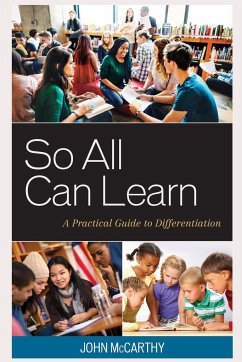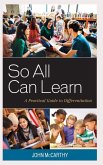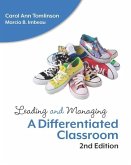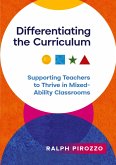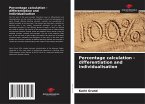- Broschiertes Buch
- Merkliste
- Auf die Merkliste
- Bewerten Bewerten
- Teilen
- Produkt teilen
- Produkterinnerung
- Produkterinnerung
How do we educate so all can learn? What does successful differentiation look like? John McCarthy shares how educators finally understand how differentiation can work. Bridging pedagogy and practice, each chapter addresses a key understanding for how good teaching practices can include differentiation with examples, concrete methods and strategies.
Andere Kunden interessierten sich auch für
![So All Can Learn So All Can Learn]() John McCarthySo All Can Learn58,99 €
John McCarthySo All Can Learn58,99 €![Differentiation in Teaching and Learning Differentiation in Teaching and Learning]() Dennis GuineyDifferentiation in Teaching and Learning50,99 €
Dennis GuineyDifferentiation in Teaching and Learning50,99 €![Leading and Managing a Differentiated Classroom Leading and Managing a Differentiated Classroom]() Carol Ann TomlinsonLeading and Managing a Differentiated Classroom31,99 €
Carol Ann TomlinsonLeading and Managing a Differentiated Classroom31,99 €![So Each May Soar So Each May Soar]() Carol Ann TomlinsonSo Each May Soar34,99 €
Carol Ann TomlinsonSo Each May Soar34,99 €![Differentiating the Curriculum Differentiating the Curriculum]() Ralph PirozzoDifferentiating the Curriculum19,99 €
Ralph PirozzoDifferentiating the Curriculum19,99 €![Percentage calculation - differentiation and individualisation Percentage calculation - differentiation and individualisation]() Karin GrundPercentage calculation - differentiation and individualisation47,99 €
Karin GrundPercentage calculation - differentiation and individualisation47,99 €![Inclusion and Differentiation in EFL Classrooms. The Role of Drama Pedagogy Inclusion and Differentiation in EFL Classrooms. The Role of Drama Pedagogy]() Lilli-Marie SchellerInclusion and Differentiation in EFL Classrooms. The Role of Drama Pedagogy11,95 €
Lilli-Marie SchellerInclusion and Differentiation in EFL Classrooms. The Role of Drama Pedagogy11,95 €-
-
-
How do we educate so all can learn? What does successful differentiation look like? John McCarthy shares how educators finally understand how differentiation can work. Bridging pedagogy and practice, each chapter addresses a key understanding for how good teaching practices can include differentiation with examples, concrete methods and strategies.
Produktdetails
- Produktdetails
- Verlag: Rowman & Littlefield Publishers
- Seitenzahl: 202
- Erscheinungstermin: 15. Februar 2017
- Englisch
- Abmessung: 229mm x 152mm x 12mm
- Gewicht: 336g
- ISBN-13: 9781475825718
- ISBN-10: 1475825714
- Artikelnr.: 46603019
- Herstellerkennzeichnung
- Libri GmbH
- Europaallee 1
- 36244 Bad Hersfeld
- gpsr@libri.de
- Verlag: Rowman & Littlefield Publishers
- Seitenzahl: 202
- Erscheinungstermin: 15. Februar 2017
- Englisch
- Abmessung: 229mm x 152mm x 12mm
- Gewicht: 336g
- ISBN-13: 9781475825718
- ISBN-10: 1475825714
- Artikelnr.: 46603019
- Herstellerkennzeichnung
- Libri GmbH
- Europaallee 1
- 36244 Bad Hersfeld
- gpsr@libri.de
John McCarthy consults and coaches educators internationally on innovative practices that support student voice, with Differentiation a core principle. Starting out as a high school teacher, and later an adjunct professor, McCarthy has taught and witnessed learning in many settings-urban to rural communities, areas of high affluence to entrenched poverty, and cultures with a fixed mindset to havens of innovation in some of the most surprising locations.
Foreword: Syndee Malek
Introduction
Chapter 1: What is Differentiation, Really?
The Challenge and Promise of Differentiation
Lens on Learning
The Differentiation Relationship
The "Real" Differentiation Relationship
Final Thoughts
Invitations to Reflections
Chapter 2: Differentiation Can Be Done Well
The Dorothy Principle
Making Differentiation Visible
Assistance When Lesson Plans Run into Students
Crossroad Lessons
Final Thoughts
Invitations to Reflection
Chapter 3: Assessments Matter: making learning specific and realistic
Assessment for Learning
Formative Assessment Cycle (FAC)
Finding Time
Multiple Ways to Demonstrate Learning
Eliminating Assessment Fog
Final Thoughts
Invitations to Reflection
Chapter 4: Informative Assessments for The Whole Learner
Learning In and Out of Airplane Mode
Choice-Based Strategies
The Whole Student: Four Data Paths that influence Learning
Fair is not always Equal: 4 Pathways Merge into One
Final Thoughts
Invitations to Reflection
Chapter 5: The Truth about Differentiated Instruction
1. Differentiation is Too Difficult
2. There is not enough time to differentiate
3. The curriculum is over packed
4. Need to prepare for the high-stakes tests by covering all the material
5. Crowded classrooms makes differentiation too difficult
Final Thoughts
Invitations to Reflection
Chapter 6: Learner Voice Matters
The Realms of Differentiation
Learner Voice over Student Choice
Letting Go of Control
Eliminating Airplane Mode in Education - Part Two
Teacher Growth-Mindset Leads to Learner Voice
Creating a Culture for Student Voice
Pedagogical Needs for Student Voice
Practical Support of Student Voice
Final Thoughts
Invitations to Reflection
Chapter 7: Differentiation in Practice: Readiness for ALL
Readiness Guidelines
Teaching Readiness through Content
Teaching Readiness through Process
Teaching Readiness through Products
Final Thoughts
Invitations to Reflection
Chapter 8: Differentiation in Practice: Interests for ALL
Interests Guidelines
Teaching Interests through Content
Teaching Interests through Processes
Teaching Interests through Products
Final Thoughts
Invitations to Reflection
Chapter 9: Differentiation in Practice: Learning Preferences for ALL
Learning Preferences Guidelines
Learning Profile Cards
Teaching Learning Preferences through Content
Teaching Learning Preferences through Processes
Teaching Learning Preferences through Products
Final Thoughts
Invitations to Reflection
Appendix: Differentiation and Research
The Differentiation Lens
Final Thoughts
Invitations to Reflection
Acknowledgments
About the Author
Introduction
Chapter 1: What is Differentiation, Really?
The Challenge and Promise of Differentiation
Lens on Learning
The Differentiation Relationship
The "Real" Differentiation Relationship
Final Thoughts
Invitations to Reflections
Chapter 2: Differentiation Can Be Done Well
The Dorothy Principle
Making Differentiation Visible
Assistance When Lesson Plans Run into Students
Crossroad Lessons
Final Thoughts
Invitations to Reflection
Chapter 3: Assessments Matter: making learning specific and realistic
Assessment for Learning
Formative Assessment Cycle (FAC)
Finding Time
Multiple Ways to Demonstrate Learning
Eliminating Assessment Fog
Final Thoughts
Invitations to Reflection
Chapter 4: Informative Assessments for The Whole Learner
Learning In and Out of Airplane Mode
Choice-Based Strategies
The Whole Student: Four Data Paths that influence Learning
Fair is not always Equal: 4 Pathways Merge into One
Final Thoughts
Invitations to Reflection
Chapter 5: The Truth about Differentiated Instruction
1. Differentiation is Too Difficult
2. There is not enough time to differentiate
3. The curriculum is over packed
4. Need to prepare for the high-stakes tests by covering all the material
5. Crowded classrooms makes differentiation too difficult
Final Thoughts
Invitations to Reflection
Chapter 6: Learner Voice Matters
The Realms of Differentiation
Learner Voice over Student Choice
Letting Go of Control
Eliminating Airplane Mode in Education - Part Two
Teacher Growth-Mindset Leads to Learner Voice
Creating a Culture for Student Voice
Pedagogical Needs for Student Voice
Practical Support of Student Voice
Final Thoughts
Invitations to Reflection
Chapter 7: Differentiation in Practice: Readiness for ALL
Readiness Guidelines
Teaching Readiness through Content
Teaching Readiness through Process
Teaching Readiness through Products
Final Thoughts
Invitations to Reflection
Chapter 8: Differentiation in Practice: Interests for ALL
Interests Guidelines
Teaching Interests through Content
Teaching Interests through Processes
Teaching Interests through Products
Final Thoughts
Invitations to Reflection
Chapter 9: Differentiation in Practice: Learning Preferences for ALL
Learning Preferences Guidelines
Learning Profile Cards
Teaching Learning Preferences through Content
Teaching Learning Preferences through Processes
Teaching Learning Preferences through Products
Final Thoughts
Invitations to Reflection
Appendix: Differentiation and Research
The Differentiation Lens
Final Thoughts
Invitations to Reflection
Acknowledgments
About the Author
Foreword: Syndee Malek
Introduction
Chapter 1: What is Differentiation, Really?
The Challenge and Promise of Differentiation
Lens on Learning
The Differentiation Relationship
The "Real" Differentiation Relationship
Final Thoughts
Invitations to Reflections
Chapter 2: Differentiation Can Be Done Well
The Dorothy Principle
Making Differentiation Visible
Assistance When Lesson Plans Run into Students
Crossroad Lessons
Final Thoughts
Invitations to Reflection
Chapter 3: Assessments Matter: making learning specific and realistic
Assessment for Learning
Formative Assessment Cycle (FAC)
Finding Time
Multiple Ways to Demonstrate Learning
Eliminating Assessment Fog
Final Thoughts
Invitations to Reflection
Chapter 4: Informative Assessments for The Whole Learner
Learning In and Out of Airplane Mode
Choice-Based Strategies
The Whole Student: Four Data Paths that influence Learning
Fair is not always Equal: 4 Pathways Merge into One
Final Thoughts
Invitations to Reflection
Chapter 5: The Truth about Differentiated Instruction
1. Differentiation is Too Difficult
2. There is not enough time to differentiate
3. The curriculum is over packed
4. Need to prepare for the high-stakes tests by covering all the material
5. Crowded classrooms makes differentiation too difficult
Final Thoughts
Invitations to Reflection
Chapter 6: Learner Voice Matters
The Realms of Differentiation
Learner Voice over Student Choice
Letting Go of Control
Eliminating Airplane Mode in Education - Part Two
Teacher Growth-Mindset Leads to Learner Voice
Creating a Culture for Student Voice
Pedagogical Needs for Student Voice
Practical Support of Student Voice
Final Thoughts
Invitations to Reflection
Chapter 7: Differentiation in Practice: Readiness for ALL
Readiness Guidelines
Teaching Readiness through Content
Teaching Readiness through Process
Teaching Readiness through Products
Final Thoughts
Invitations to Reflection
Chapter 8: Differentiation in Practice: Interests for ALL
Interests Guidelines
Teaching Interests through Content
Teaching Interests through Processes
Teaching Interests through Products
Final Thoughts
Invitations to Reflection
Chapter 9: Differentiation in Practice: Learning Preferences for ALL
Learning Preferences Guidelines
Learning Profile Cards
Teaching Learning Preferences through Content
Teaching Learning Preferences through Processes
Teaching Learning Preferences through Products
Final Thoughts
Invitations to Reflection
Appendix: Differentiation and Research
The Differentiation Lens
Final Thoughts
Invitations to Reflection
Acknowledgments
About the Author
Introduction
Chapter 1: What is Differentiation, Really?
The Challenge and Promise of Differentiation
Lens on Learning
The Differentiation Relationship
The "Real" Differentiation Relationship
Final Thoughts
Invitations to Reflections
Chapter 2: Differentiation Can Be Done Well
The Dorothy Principle
Making Differentiation Visible
Assistance When Lesson Plans Run into Students
Crossroad Lessons
Final Thoughts
Invitations to Reflection
Chapter 3: Assessments Matter: making learning specific and realistic
Assessment for Learning
Formative Assessment Cycle (FAC)
Finding Time
Multiple Ways to Demonstrate Learning
Eliminating Assessment Fog
Final Thoughts
Invitations to Reflection
Chapter 4: Informative Assessments for The Whole Learner
Learning In and Out of Airplane Mode
Choice-Based Strategies
The Whole Student: Four Data Paths that influence Learning
Fair is not always Equal: 4 Pathways Merge into One
Final Thoughts
Invitations to Reflection
Chapter 5: The Truth about Differentiated Instruction
1. Differentiation is Too Difficult
2. There is not enough time to differentiate
3. The curriculum is over packed
4. Need to prepare for the high-stakes tests by covering all the material
5. Crowded classrooms makes differentiation too difficult
Final Thoughts
Invitations to Reflection
Chapter 6: Learner Voice Matters
The Realms of Differentiation
Learner Voice over Student Choice
Letting Go of Control
Eliminating Airplane Mode in Education - Part Two
Teacher Growth-Mindset Leads to Learner Voice
Creating a Culture for Student Voice
Pedagogical Needs for Student Voice
Practical Support of Student Voice
Final Thoughts
Invitations to Reflection
Chapter 7: Differentiation in Practice: Readiness for ALL
Readiness Guidelines
Teaching Readiness through Content
Teaching Readiness through Process
Teaching Readiness through Products
Final Thoughts
Invitations to Reflection
Chapter 8: Differentiation in Practice: Interests for ALL
Interests Guidelines
Teaching Interests through Content
Teaching Interests through Processes
Teaching Interests through Products
Final Thoughts
Invitations to Reflection
Chapter 9: Differentiation in Practice: Learning Preferences for ALL
Learning Preferences Guidelines
Learning Profile Cards
Teaching Learning Preferences through Content
Teaching Learning Preferences through Processes
Teaching Learning Preferences through Products
Final Thoughts
Invitations to Reflection
Appendix: Differentiation and Research
The Differentiation Lens
Final Thoughts
Invitations to Reflection
Acknowledgments
About the Author

